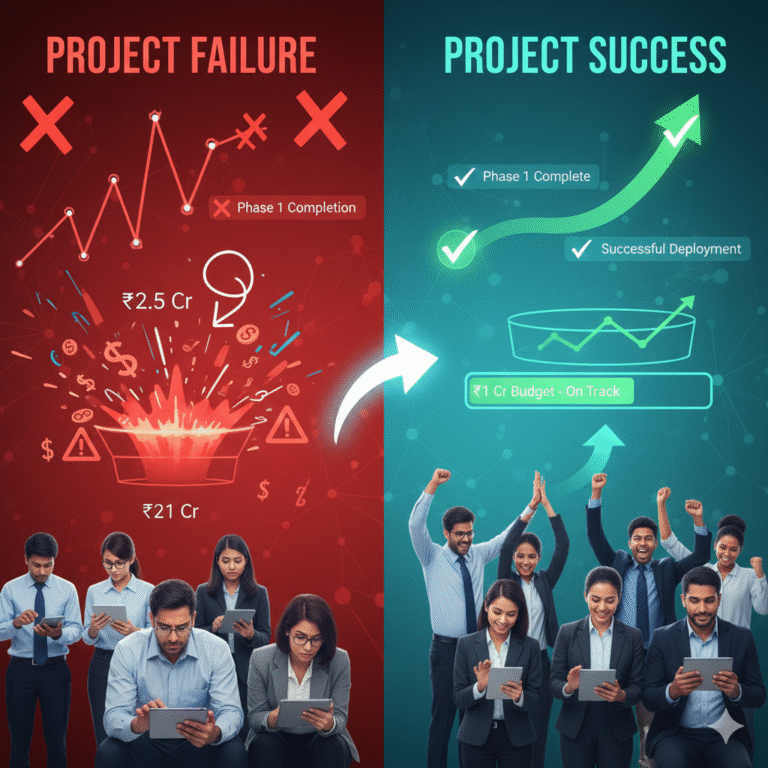Key Highlights
- India’s BPM sector is dramatically outperforming traditional IT services, with AI-driven Advanced Technology Solutions (ATS) growing 17-20% while generating significantly higher margins than legacy infrastructure services.
- The government’s Rs 1 lakh crore Research, Development and Innovation (RDI) scheme under ANRF channels strategic funding into quantum technologies, semiconductors, and AI applications to establish tech sovereignty.
- India’s quantum computing market is projected to surge from $1 billion in 2024 to $7 billion by 2032 with a 27% CAGR, anchored by indigenous breakthroughs like QpiAI’s 64-qubit Kaveri chip launching commercially in Q3 2026.
- BPM revenue streams are inverting—digital revenue will represent 60-70% of industry income by 2025, up from 30% five years ago, fundamentally reshaping the competitive landscape.
- Industry leaders across 85% of surveyed companies stress urgent need for massive R&D investments, talent development in quantum and AI, and government-private sector collaboration to capture multi-trillion-dollar global deep tech markets.
India stands at an inflection point. While the world obsesses over Silicon Valley’s generative AI arms race, India is orchestrating a multidimensional technological transformation that could reshape global tech economics. The nation’s Business Process Management sector is pulling away from traditional IT services through aggressive AI adoption. Simultaneously, quantum computing dreams are becoming commercial reality. And a bold Rs 1 lakh crore national investment in semiconductors and deep tech signals an unmistakable pivot toward technological sovereignty.
This isn’t just incremental innovation—it’s structural transformation. Understanding these intersecting trends is critical for investors, enterprises, policymakers, and anyone positioned at the intersection of India’s digital economy and global tech competition.
BPM Sector Riding the AI Wave: Why It’s Winning
What exactly is a BPM company, and why does it matter?
Business Process Management companies operate at the nerve center of global enterprise operations. Unlike traditional IT services focused on infrastructure, applications, and consulting, BPM firms specialize in outsourcing and automating specific business functions—customer service, finance processing, human resources operations, supply chain management.
India dominates this space, with companies like Genpact, EXL, and smaller players generating nearly $49 billion in annual revenue by FY24 and exporting 95% of services primarily to North America and Europe. cio.eletsonline
But something seismic is happening now. The convergence of AI, machine learning, and robotic process automation (RPA) is fundamentally rewriting the BPM playbook.

The AI acceleration is accelerating within BPM:
Advanced Technology Solutions (ATS) segments at major BPM firms are growing at 17-20% year-over-year, dramatically outpacing traditional Digital Operations growth of just 4-5%. Genpact’s Data-Tech-AI revenues reached $599 million in Q2 2025, expanding at 9.7% year-on-year while maintaining robust gross margins of 35.9%.
The critical advantage here transcends simple automation. BPM companies are deploying “Large Process Models” and agentic AI systems that don’t merely execute repetitive tasks—they reason, make autonomous decisions, and collaborate with human expertise to solve complex problems at scale.
Diwakar Singhal, Global Business Leader at Genpact, articulated this fundamental shift: AI isn’t replacing human workers. Rather, it’s creating AI-augmented human roles where employees work alongside intelligent systems, multiplying productivity while elevating job quality.
For business leaders and investors, the margin story is compelling. Traditional BPM services operate with gross margins of 30-35%. As companies shift revenue mix toward AI-enhanced solutions, margin profiles are expanding significantly. Genpact has raised adjusted operating margin targets to 17.4%, with mid-term expectations of 25 basis points expansion. This margin expansion, combined with sustained double-digit ATS growth, creates a powerful earnings inflection for BPM-exposed portfolios.
Why are BPM firms outpacing broader IT services? Traditional IT companies face structural headwinds. The pyramid model—junior developers executing routine code and infrastructure tasks—is eroding as AI automates exactly those functions. BPM firms, by contrast, started from process automation foundations and are naturally evolving toward intelligent automation, positioning them to capture significantly more value than legacy IT services companies struggling with organizational restructuring.
BPM Versus Traditional IT: Diverging Destinies
The divergence between BPM and traditional IT services represents one of the most consequential sector rotations in India’s technology landscape.
Traditional IT Services Under Pressure
India’s IT sector—companies like TCS, Infosys, Wipro, and HCL—generated $264 billion in exports during FY25, making India the undisputed global IT services leader. Yet this apparent strength masks structural vulnerabilities. Samir Arora, CEO of Helios Capital, warned that the conventional labor-intensive pyramid model is breaking under AI’s weight. scanx
The traditional IT organizational structure—armies of junior developers executing defined tasks with senior architects overseeing quality—is fundamentally threatened when AI can generate functional code, debug systems, and handle configuration management. This compression threatens entry-level employment pipelines that have historically funded career progression. More critically, it pressures pricing: clients, seeing AI-driven productivity gains, are demanding price reductions rather than investing incremental spending in expanded digital transformation.
Short-term reality: IT sector guidance suggests revenue growth will moderate to 1.1% year-on-year in FY26, rising modestly to 5.4% in FY27—far below historical 8%+ CAGRs. Operating margins have improved through currency tailwinds and efficiency programs, but underlying pricing pressure persists. timesofindia

BPM’s Structural Advantage
BPM companies operate from fundamentally different market dynamics. Rather than selling discrete project services, they manage ongoing processes for clients, creating recurring revenue streams and deep operational integration.
This creates several advantages:
Margin Protection: BPM contracts feature higher switching costs and longer payback horizons, supporting pricing power even as productivity improves. Gross margins have remained stable at 35-36%, and Genpact achieved net margins exceeding 10.6% in Q2 2025—demonstrating margin expansion amid cost control.
AI Amplification Rather Than Replacement: Process automation is BPM’s DNA. When AI emerges, BPM firms don’t require organizational restructuring—they simply upgrade existing automation with intelligence. This evolutionary advantage allows BPM leaders to capture AI value through enhanced productivity rather than sacrificing margins.
Client Demand Inversion: As enterprises accelerate digital transformation, they’re shifting spending from infrastructure and project-based services toward outcome-focused process outsourcing. This demand inflection favors BPM firms offering measurable productivity improvements and cost optimization.
Talent Dynamics: While traditional IT struggles with talent utilization amid AI automation, BPM firms are hiring specialists in advanced analytics, AI implementation, and process optimization—roles commanding premium compensation and fostering sustained revenue growth.
What this means for portfolios: Sector rotation favoring BPM over traditional IT services isn’t cyclical—it’s structural. Investors recognizing this divergence are repositioning accordingly, with BPM stocks commanding premium valuations on superior growth and margin visibility.
India’s Rs 1 Lakh Crore Quantum-Semiconductor Bet: Tech Sovereignty Redefined
If BPM represents near-term earnings opportunity, India’s quantum and semiconductor investments represent long-term strategic imperative—and enormous wealth creation potential.
The scale of India’s commitment is staggering. In November 2025, the government formally launched the Rs 1 lakh crore (approximately $12 billion USD equivalent) Research, Development and Innovation (RDI) scheme under the Anusandhan National Research Foundation (ANRF). This complements the existing ₹76,000 crore India Semiconductor Mission approved for fabrication, assembly, and testing infrastructure.
Why this investment magnitude matters:
Tech sovereignty has become a geopolitical imperative. China controls 80% of semiconductor production capacity. Taiwan accounts for most advanced chip design. The U.S., while declining in manufacturing, maintains irreplaceable intellectual property and design leadership. India, consuming advanced chips at rapidly accelerating rates, faces critical vulnerability: dependence on potentially hostile or unstable supply chains.
The Rs 1 lakh crore RDI scheme directly addresses this, funding projects in quantum technologies, semiconductors, neuromorphic processors, edge AI accelerators, and indigenous AI chips.
India’s Quantum Computing Breakthrough: From Research to Commercial Reality
The quantum segment represents perhaps the most exciting near-term milestone. Indian startup QpiAI unveiled its 64-qubit superconducting quantum processor, “Kaveri,” in November 2025, with commercial availability targeted for Q3 2026.
This achievement carries enormous symbolic and practical weight. For context: India’s National Quantum Mission, established in 2023 with ₹6,003.65 crore budget through 2030-31, positioned India as the seventh country globally with dedicated quantum strategy.
Kaveri’s significance:
- Hardware leadership: Moving from 25-qubit Indus to 64-qubit Kaveri demonstrates India’s quantum hardware trajectory.
- Roadmap credibility: QpiAI already targets 128-qubit “Ganges” and 1,000-qubit systems by 2030, signaling serious long-term commitment rather than one-off achievement.
- Application domains: Immediate use-cases span cryptography, AI optimization, material science, and drug discovery—sectors where quantum advantage will deliver transformative value.
- Indigenous manufacturing: The Kaveri ecosystem requires cryogenics, quantum control electronics, fabrication capabilities—essentially building India’s quantum industrial base from ground up.
Market opportunity: India’s quantum market is projected to surge from $1 billion in 2024 to $7 billion by 2032 with a 27% CAGR. That’s conservative—global quantum markets could reach tens of billions as practical quantum applications mature.

Semiconductor Ambitions: Manufacturing Hub Emergence
The semiconductor story is equally strategic. While quantum represents cutting-edge future capability, semiconductors represent immediate, massive economic impact.
Current status:
Ten semiconductor projects totaling ₹1.60 lakh crore ($18.23 billion USD) investment have been approved across Gujarat, Assam, Andhra Pradesh, Punjab, and Odisha. These include:
- Tata Electronics’ ₹91,000 crore mega-fab in Gujarat with PSMC partnership, producing 50,000 wafers monthly.
- Tata’s ₹27,000 crore assembly facility in Assam, producing 48 million chips daily.
- Micron’s ₹22,516 crore ATMP facility in Gujarat.
- Andhra Pradesh’s ₹23,000 crore Indichip semiconductor hub in Kurnool.
Timeline acceleration: Minister Jitin Prasada confirmed the first packaged chip will be ready by December 2025, with substantial production ramping through 2026-27.
Strategic importance:
This manufacturing base addresses multiple imperatives. Immediate applications span smartphones, automobiles, 5G infrastructure, and defense systems. Mid-term, these fabrication capabilities provide foundation for advanced chip design and packaging. Long-term, India captures value across the entire semiconductor value chain rather than remaining perpetually dependent on imported chips.
For investors: Semiconductor ecosystem growth will benefit multiple sectors—equipment suppliers, materials science, packaging specialists, and software design firms. Companies positioned to serve this manufacturing boom will capture disproportionate value.
Sector-Specific Winners: Where Quantum, Semiconductors, and AI Converge
Not all sectors benefit equally from India’s tech transformation. Strategic investors must identify which segments capture disproportionate value.
Primary beneficiaries:
Defense and Cybersecurity: India’s defense sector desperately needs computational advantage and cryptographic superiority. Quantum computing promises both. Companies engaged in defense tech, cybersecurity infrastructure, and secure communication systems will see accelerated adoption and pricing power.
Infrastructure and Manufacturing: Semiconductor fabrication requires massive capital infrastructure—cleanrooms, cryogenic systems, advanced measurement equipment. Indian and multinational companies capable of building this infrastructure capture enormous value.
Advanced Materials and Testing: Quantum-optimized materials science, chip testing automation, and process verification demand sophisticated equipment and software. Startups and specialized service providers in these domains face robust demand.
Regional SMEs and Startups: India’s deep tech ecosystem benefits from government incentives, access to government-backed infrastructure, and reducing dependence on imported components. Small and medium enterprises previously priced out of quantum and semiconductor work are gaining access to labs, computing resources, and partnership opportunities.
AI Training and Analytics: As BPM firms scale AI capabilities and quantum systems demand new algorithms, demand for specialized AI training, data annotation, analytics infrastructure, and quantum algorithm development explodes.
Market Sentiment, Policy Uncertainty, and Investment Implications
India’s technology transformation is generating palpable investor enthusiasm, yet critical uncertainties linger.
Positive catalysts:
- BPM sector outperformance is attracting global capital, with premium valuations reflecting visible margin expansion and AI revenue inflection.
- Quantum breakthroughs (Kaveri launch, NQM achievements) are validating India’s technological capability, building confidence among multinational quantum players to expand Indian operations.
- Semiconductor progress is attracting foreign direct investment, with Taiwan’s PSMC, Japan’s Renesas, and South Korea’s APACT committing to India partnerships.
- Government policy consistency since 2014, manifested through ISM, NQM, ANRF funding, and Make in India incentives, provides investors with confidence in sustained long-term commitment.
Risk considerations:
- Execution risk: Semiconductor manufacturing requires exceptional precision and massive capital discipline. Historical Indian manufacturing projects have faced schedule delays and cost overruns. Quantum technology remains nascent globally—India’s ability to commercialize quantum systems faster than established players (IBM, Google, IonQ) remains unproven.
- Geopolitical volatility: U.S.-China competition and potential Trump administration trade policies create unpredictability around quantum technologies, semiconductor export controls, and technology transfer restrictions affecting India.
- Talent constraints: Both quantum and semiconductor ecosystems demand extremely specialized talent. India’s projected need for one million semiconductor professionals by 2032 represents enormous reskilling challenge. Similarly, quantum computing demands expertise in superconducting physics, cryogenics, and quantum algorithms—talent pools India is only beginning to develop.
- IT sector transition uncertainty: While BPM outperformance appears durable, traditional IT sector uncertainty persists. Market sentiment remains cautious, with multiple compression visible across IT stocks as investors model lower growth and margin pressure.
Strategic Recommendations: Portfolio Positioning and Stakeholder Action Items
For investors: The opportunity set in India’s technology transformation is multifaceted yet requires nuanced positioning.
Direct BPM exposure through companies like Genpact and EXL offers relatively near-term earnings inflection, visible margin expansion, and defensible business models. BPM sector outperformance should persist 3-5 years as AI adoption deepens.
Semiconductor and quantum plays demand longer time horizons (5-10 years) but offer profound wealth creation potential. Direct exposure to QpiAI, TCS Quantum initiatives, or Indian semiconductor equipment suppliers captures early-stage positioning in emerging mega-trends.
IT sector consolidation: Rather than broad IT sector exposure, target companies proactively reshaping toward AI consulting, product engineering, and automation management—firms demonstrating tangible pivots toward higher-value services.
For enterprises: Companies dependent on technology services must reassess vendor strategies. BPM providers should increasingly embed AI capabilities in contracts to justify pricing and protect margins. IT services buyers should shift toward outcome-based pricing reflecting AI-driven efficiency gains.
For policymakers: India’s quantum-semiconductor strategy is strategically sound, but execution requires relentless focus on talent development, infrastructure quality, and removing bureaucratic friction. Expedited visa policies for specialized quantum and semiconductor talent, accelerated approval for critical equipment imports, and sustained funding commitment will determine success.
For talent: The talent shortage in quantum computing and semiconductor design represents career opportunity. Professionals developing expertise in quantum algorithms, quantum systems, advanced semiconductor design, and AI process optimization will command premium compensation for decades.
Future Outlook: Structural Transformation Through 2030 and Beyond
The 2025-2030 period is critical. Quantum systems move from laboratory to commercial deployment. Semiconductor fabs transition from construction to full-scale production. BPM firms complete organizational transitions from labor-intensive to AI-augmented models. AI infrastructure reaches production maturity across enterprises.
By 2030, India’s technology landscape should resemble:
- BPM sector exceeding $60-75 billion revenue, with 70%+ from AI-driven advanced technology solutions, operating at 17-18% net margins.
- Quantum computing market reaching $5-7 billion, with India capturing 15-20% share through indigenous Kaveri-class systems and algorithm expertise.
- Semiconductor manufacturing reaching $50 billion+ revenue, with India producing 10-15% of global chips, dramatically reducing import dependence.
- AI and advanced analytics markets incorporating quantum capabilities, enabling breakthrough applications in drug discovery, materials science, financial modeling, and cryptography.
Global implications are staggering. If India successfully executes this transformation, it fundamentally reshapes technology economics. A diversified, domestically-manufactured tech base reduces dependencies on potentially hostile actors. A vibrant quantum computing industry accelerates global quantum adoption. Homegrown AI solutions adapted to Indian contexts (agriculture, healthcare, education) export globally and create competitive alternatives to Western AI platforms.
Conclusion

India’s technology transformation isn’t merely economic—it’s geopolitical and societal. The BPM sector’s AI-driven outperformance creates immediate financial opportunity. The quantum computing breakthrough validates India’s deep tech capability. The Rs 1 lakh crore semiconductor investment signals unwavering strategic commitment.
Yet opportunity demands action. Investors must position portfolios strategically, balancing near-term BPM exposure with longer-term quantum-semiconductor upside. Enterprises must embed AI into vendor relationships and operational models. Policymakers must sustain funding, accelerate talent development, and remove execution friction. Talent must upskill aggressively in quantum, semiconductors, and advanced AI domains.
The question isn’t whether India will lead in BPM, quantum, or semiconductors. The strategic commitment and early evidence suggest yes. The question is whether stakeholders move with sufficient urgency to capitalize on the opportunity.









+ There are no comments
Add yours